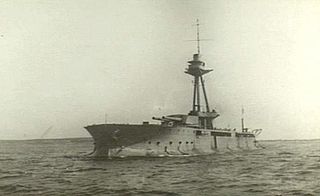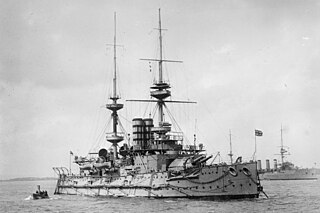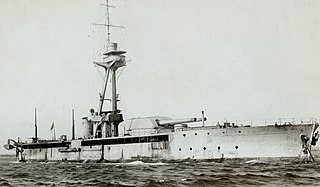
The M29 class comprised five monitors of the Royal Navy, all built and launched during 1915.

HMS Raglan was a First World War Royal Navy Abercrombie-class monitor, which was sunk during the Battle of Imbros in January 1918.

The Lord Clive-class monitor, sometimes referred to as the General Wolfe class, were ships designed for shore bombardment and were constructed for the Royal Navy during the First World War.

The Marshal Ney class was a class of monitor built for the Royal Navy during the First World War.

HMS Abercrombie was a First World War Royal Navy Abercrombie-class monitor.

HMS Crusader was a Tribal class destroyer of the Royal Navy launched in 1909. During the First World War she served in the North Sea and the English Channel with the 6th Destroyer Flotilla. Following the War she was sold for scrap to Thos. W. Ward on 30 June 1920 for scrapping at Preston.

HMS Sir Thomas Picton was a First World War Royal Navy Lord Clive-class monitor. Sir Thomas Picton was the only Royal Navy ship ever named for Sir Thomas Picton, a British general of the Peninsula War who was killed at the Battle of Waterloo. The ship's original 12" main battery was stripped from the obsolete Majestic-class battleship HMS Mars.
HMS Prince Eugene was one of eight Lord Clive-class monitors built for the Royal Navy in 1915 to conduct shore bombardments during the First World War. The ship was assigned to the Dover Patrol for the duration of the war and provided cover for the Inshore Squadron during the First Ostend Raid. She was sold for scrap in 1921.

HMS Prince Rupert was a First World War Royal Navy Lord Clive-class monitor named after Prince Rupert of the Rhine, an important Royalist commander of the English Civil War and key figure in the Restoration navy. Although she is the only ship of the Royal Navy to have ever had this precise name, other ships have been named after Prince Rupert as HMS Rupert. Her 12" main battery was stripped from the obsolete Majestic-class battleships.
HMS Sir John Moore was one of eight Lord Clive-class monitors built for the Royal Navy in 1915 to conduct shore bombardments during the First World War. The ship was assigned to the Dover Patrol for the duration of the war and was sold for scrap in 1921.

HMS Mars was a Royal Navy pre-dreadnought battleship of the Majestic class, the seventh member of a class of nine ships. The ship was laid down in the Laird Brothers shipyard in June 1894, she was launched in March 1896, and she was commissioned into the fleet in June 1897. She was armed with a main battery of four 12-inch (305 mm) guns and a secondary battery of twelve 6-inch (152 mm) guns. The ship had a top speed of 16 knots.

HMS Havelock was an Abercrombie-class monitor of the Royal Navy that saw service in the First World War.

HMS Roberts was an Abercrombie class monitor of the Royal Navy that served in the First World War.

HMS Roberts was a Royal Navy Roberts-class monitor of the Second World War. She was the second monitor to be named after Field Marshal Frederick Roberts, 1st Earl Roberts.

HMS M31 was an M29-class monitor of the Royal Navy.
HMS M28 was a First World War Royal Navy M15-class monitor. She was sunk during the Battle of Imbros in 1918.
HMS M27 was a First World War Royal Navy M15-class monitor. She was also served in the British intervention in Russia in 1919, and was scuttled in the Dvina River on 16 September 1919.
HMS M25 was a First World War Royal Navy M15-class monitor. She was also served in the British intervention in Russia in 1919, and was scuttled in the Dvina River on 16 September 1919.
HMS M22 was a First World War Royal Navy M15-class monitor. Later converted to a minelayer and renamed HMS Medea, she was wrecked whilst being towed for breaking up on 2 January 1939.














